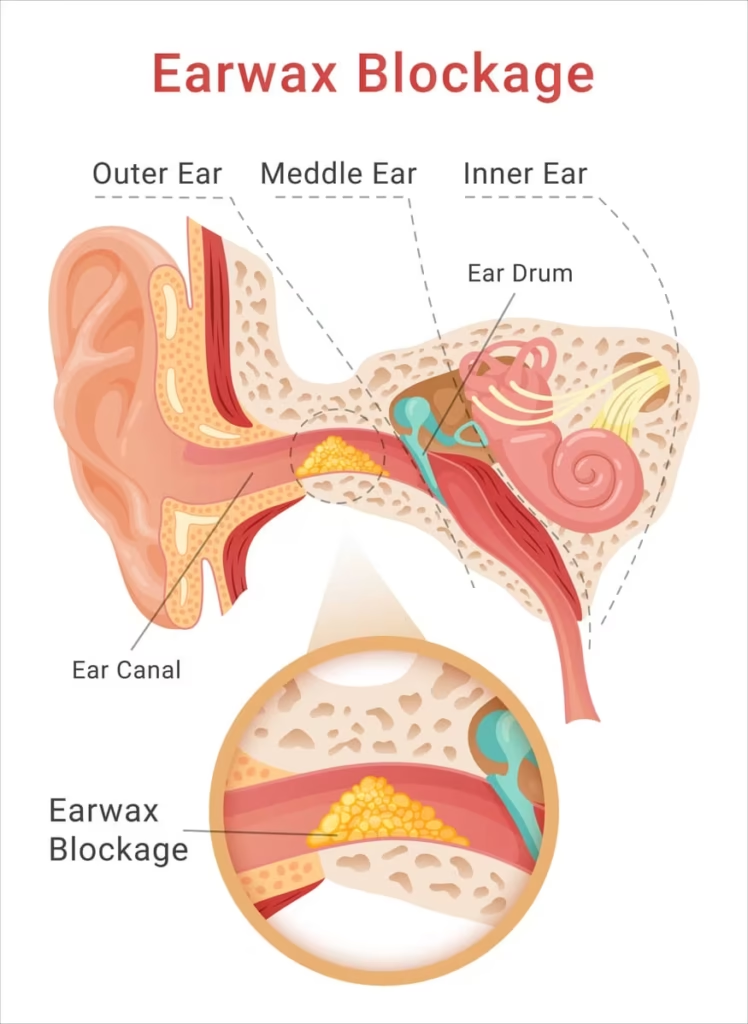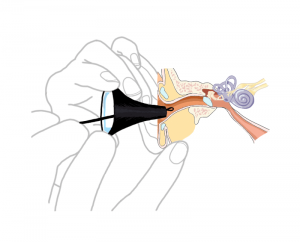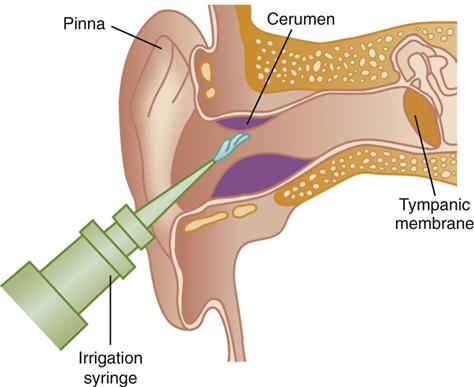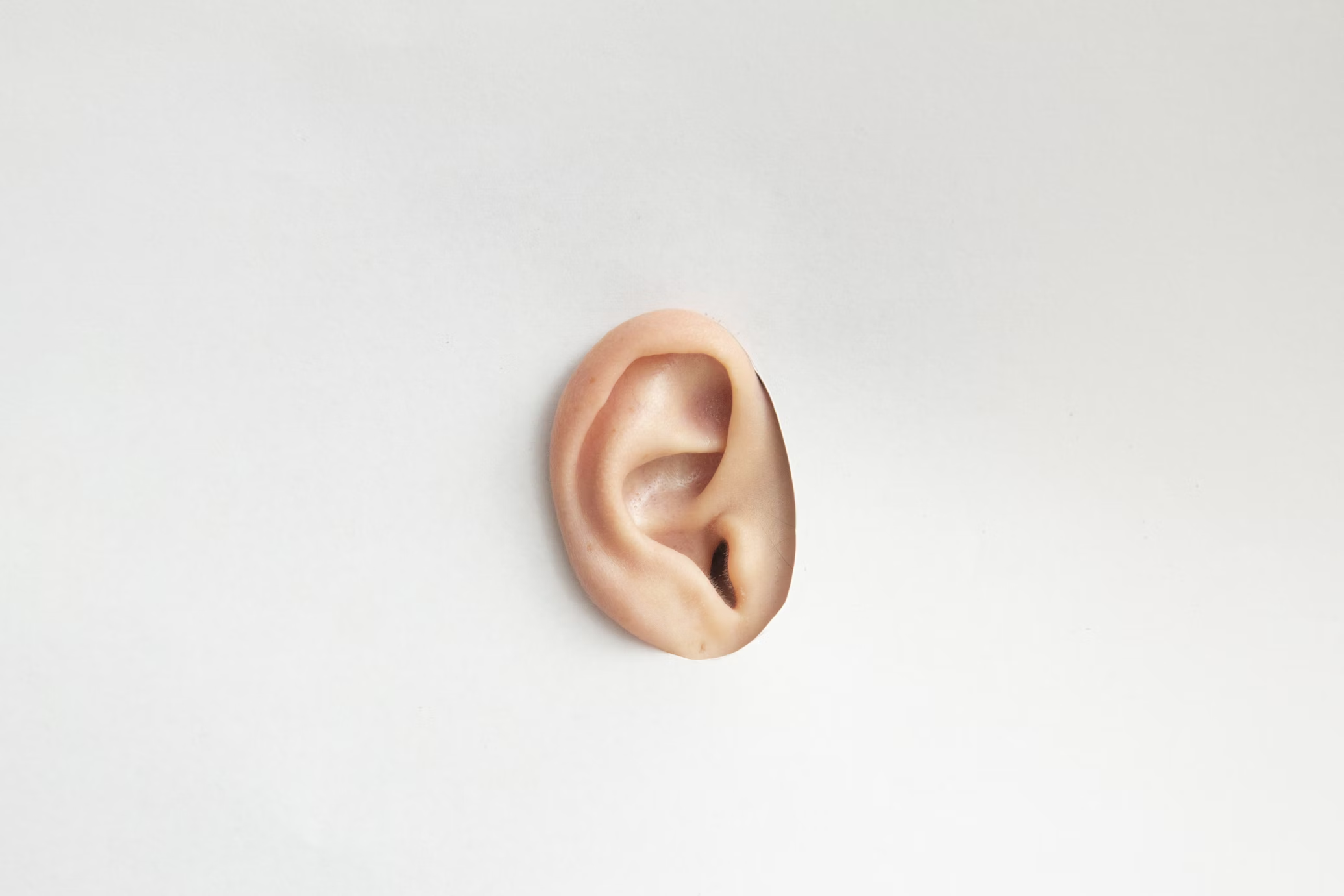Understanding Earwax and Why It Can Become Problematic
Earwax (cerumen) serves as a natural protective mechanism for our ears. This yellowish, waxy substance is produced by glands in the ear canal and plays several important roles: it traps dust and foreign particles, prevents them from reaching the eardrum, provides lubrication, and even offers antimicrobial protection against potential infections.
While earwax production is completely natural and beneficial, excessive accumulation can lead to various complications.
Your ears typically maintain a self-cleaning mechanism where old earwax naturally migrates toward the ear opening and falls out.
However, this process can sometimes be disrupted, resulting in earwax buildup that causes blockages.
Related article: Which ENT Doctor in Singapore Should You Consider?
Identifying Earwax Blockage Symptoms

Recognizing the signs of excessive earwax accumulation is crucial for timely intervention and appropriate treatment.
If you’re experiencing certain telltale symptoms, you might be dealing with an earwax blockage that requires professional attention.
Common symptoms include diminished hearing or a sensation of muffled sounds, which often serves as the first indication of a blockage.
Many people experience persistent ear discomfort or pain, along with a feeling of fullness or pressure in the affected ear that can be quite bothersome.
Tinnitus, characterized by ringing, buzzing, or humming sounds, is another frequent symptom that can significantly impact quality of life.
Additional symptoms may include dizziness or a sense of imbalance, which occurs when the blockage affects the ear’s role in maintaining equilibrium.
Some individuals experience itchiness in the ear canal, while others notice discharge or odor from the ear.
In certain cases where ear and throat nerve pathways interact, persistent coughing may even occur as a related symptom.
It’s important to understand that these symptoms can also indicate other ear conditions, which is why professional assessment is recommended rather than attempting self-diagnosis and treatment.
Why Professional Earwax Removal Is Essential
Many people attempt to remove earwax at home using cotton buds, ear candles, or other improper tools, but these approaches can be both dangerous and counterproductive.
Cotton buds often push wax deeper into the ear canal, actually worsening the blockage rather than resolving it.
Self-cleaning attempts can damage the sensitive skin of the ear canal, leading to irritation and potential complications.
More seriously, there’s a significant risk of perforating the eardrum when using inappropriate tools, which can potentially cause permanent hearing damage.
These improper removal methods may also introduce infection-causing bacteria into the ear canal, creating additional health problems.
Furthermore, home remedies frequently fail to effectively address the underlying issue and may only provide temporary relief.
When earwax accumulation causes discomfort or affects your hearing, seeking professional removal services is the safest and most effective approach to ensure proper treatment without complications.
Earwax Removal Methods in Singapore
Singapore offers several professional earwax removal techniques, with micro-suction emerging as the gold standard in recent years. Let’s explore the available methods:
Micro-suction: The Premier Technique

Micro-suction has become the preferred method of earwax removal among medical professionals in Singapore due to its precision, safety, and effectiveness.
How Micro-suction Works
During a micro-suction procedure, the process follows a carefully controlled sequence designed to maximize safety and effectiveness.
The doctor uses a specialized ear microscope that provides detailed visualization of the ear canal, allowing for precise identification of the blockage and surrounding structures.
A thin suction device then gently removes the earwax without introducing water or other substances that might cause discomfort or complications.
The procedure allows for precise control and dual-handed working by the specialist, enabling them to manipulate instruments while maintaining clear visualization throughout the process.
The entire micro-suction procedure typically takes between 10 to 15 minutes, depending on the extent of the blockage and the complexity of the individual case.
Advantages of Micro-suction
Micro-suction offers numerous benefits that have established it as the leading earwax removal technique:
- Superior visualization: The ear microscope allows doctors to see exactly what they’re doing, minimizing risk
- Dry procedure: No water is used, eliminating the risk of retained moisture that can cause infections
- Gentle and targeted: Only the problematic earwax is removed, leaving the beneficial wax intact
- Minimal discomfort: Most patients report little to no discomfort during the procedure
- Suitable for complex cases: Effective for impacted earwax, foreign bodies, and abnormal ear discharge
- Safe for vulnerable patients: Appropriate for those with perforated eardrums or previous ear surgeries
- Immediate results: Provides instant relief from blockage symptoms
Ear Irrigation (Ear Syringing)

While micro-suction has largely superseded ear irrigation as the preferred method, syringing is still available in some clinics in Singapore.
How Ear Irrigation Works
This method involves:
- Directing a controlled water jet toward the earwax
- Using water pressure to dislodge and flush out the accumulated wax
- Collecting the expelled wax and water in a basin
Limitations and Risks of Ear Irrigation
Despite being relatively effective in some cases, ear irrigation comes with several significant drawbacks that patients should carefully consider.
The procedure carries potential for injury to the delicate skin lining the ear canal, which can lead to irritation and discomfort.
There’s also a risk of eardrum perforation, especially if there’s an undiagnosed existing perforation that the healthcare provider is unaware of.
Patients may experience vertigo and other vestibular complications following ear irrigation, which can affect balance and cause dizziness.
The procedure is not suitable for patients with certain conditions, including middle ear diseases or a history of ear surgery.
In cases where the blockage is complete, irrigation can actually push wax deeper into the ear canal, worsening the problem rather than solving it.
Additionally, retained water from the irrigation process may create an environment conducive to bacterial growth, potentially leading to infections.
The procedure is less precise than micro-suction and offers limited visibility during the process, making it more difficult for healthcare providers to assess progress and avoid complications.
Cerumenolytic Ear Drops
Cerumenolytic ear drops are sometimes used as a preparatory step before mechanical removal or for addressing minor blockages.
These specialized drops help soften and dissolve earwax, making subsequent removal easier and more comfortable.
They are available both over-the-counter and by prescription, depending on the specific formulation and strength required.
These drops typically contain active ingredients like hydrogen peroxide, various oils, or saline solutions that work to break down hardened wax.
While they may be sufficient for minor buildups, they are generally not effective for significant blockages that require professional intervention.
Healthcare providers often recommend using these drops before micro-suction procedures to soften hardened wax, making the removal process more efficient and comfortable.
Who Should Consider Professional Earwax Removal?
Professional earwax removal is particularly beneficial for:
- Patients with ear infections: Micro-suction is especially recommended as irrigation is contraindicated
- Individuals with symptomatic earwax buildup: Those experiencing hearing loss, discomfort, or other symptoms
- People with anatomical variations: Certain ear canal structures are more prone to wax accumulation
- Hearing aid users: Earwax can interfere with hearing aid function and increase feedback issues
- Children with blockage symptoms: Who are able to remain still and follow instructions
- Elderly individuals: Age-related changes can affect natural earwax migration
- Patients with a history of impacted earwax: Those who regularly experience blockages
Special Considerations
You should inform your healthcare provider if you have:
- Previous ear surgeries
- Ear implants
- History of perforated eardrum
- Skin conditions like eczema or psoriasis that affect the ear
- Previous adverse reactions to earwax removal procedures
The Micro-suction Procedure: What to Expect
If you’re scheduled for micro-suction earwax removal in Singapore, here’s what you can anticipate during your appointment:
Before the Procedure
Before undergoing any earwax removal procedure, you should inform your healthcare provider about relevant aspects of your medical history.
This includes any previous ear surgeries that may have altered your ear anatomy or healing capacity.
If you have ear implants of any kind, your provider needs to know this information to choose the most appropriate removal method.
A history of perforated eardrum is particularly important to disclose, as this affects which removal techniques can be safely used.
Skin conditions like eczema or psoriasis that affect the ear area should also be mentioned, as these can influence healing and susceptibility to irritation.
Finally, any previous adverse reactions to earwax removal procedures should be discussed to prevent similar complications.
During the Procedure
The micro-suction process typically involves:
- Positioning: You’ll be seated comfortably, with your head positioned to give the doctor good access to your ear
- Ear canal access: The doctor will gently pull your outer ear and insert a speculum (a cone-shaped instrument that helps keep the ear canal open)
- Microscope focusing: The specialized ear microscope will be positioned to provide clear visualization of your ear canal
- Suction process: You’ll hear a soft noise as the suction device removes the earwax
- The doctor may need to pause occasionally to clear the suction tip if it becomes clogged
- You’ll need to remain still during this process
- Inspection: After removing the visible wax, the doctor will thoroughly examine your ear canal and eardrum
The entire procedure typically takes 10-15 minutes per ear, though this can vary depending on the amount and consistency of the earwax.
After the Procedure
Following micro-suction:
- Hearing assessment: Your doctor may conduct a basic hearing test to confirm improvement
- Aftercare instructions: You’ll receive advice on ear care and prevention of future blockages
- Follow-up: In some cases, particularly if the blockage was severe, a follow-up appointment may be recommended
Most patients experience immediate relief from blockage symptoms, with improved hearing and reduced discomfort noted right after the procedure.
Benefits of Professional Earwax Removal
The advantages of seeking professional earwax removal extend far beyond simply clearing a blockage.
Restored hearing is often the most immediately noticeable benefit, with patients experiencing significant improvement in hearing capabilities once the obstruction is removed.
This leads to alleviation of associated symptoms, providing relief from discomfort, pressure, tinnitus, and other bothersome effects.
Professional removal also focuses on prevention of complications, as trained specialists can reduce the risk of infections and eardrum damage that might occur with improper home treatments.
The procedure provides a valuable diagnostic opportunity, allowing for thorough examination of the ear canal and eardrum that may identify other issues requiring attention.
Patients benefit from expert care provided by trained specialists who understand ear anatomy and pathology, ensuring safe and effective treatment.
Additionally, these appointments offer educational value, as healthcare providers can offer guidance on proper ear care and prevention strategies to reduce future problems.
Special Benefits for Elderly Patients
For elderly individuals, professional earwax removal can be particularly valuable and life-changing.
The procedure can restore hearing that significantly affects social interactions and overall quality of life, helping seniors maintain important connections with family and friends.
Improved hearing may also help enhance cognitive function that can be negatively impacted by sensory deprivation.
Professional removal reduces risks of falls and accidents that are often associated with balance issues caused by ear blockages, which is especially important for elderly patients who may already be at higher risk for falls.
For those who use hearing aids, professional earwax removal ensures proper hearing aid function, maximizing the benefit of these important assistive devices.
Preventing Earwax Buildup
While earwax production is natural and beneficial for ear health, you can take several important steps to prevent problematic accumulation.
The most crucial rule is to avoid inserting any objects into your ear canal, including cotton buds, hairpins, or other items that can push wax deeper or cause injury.
Practice proper ear cleaning by cleaning only the outer ear with a washcloth, avoiding any attempts to clean inside the ear canal.
For those prone to excessive buildup, consider occasional use of preventive softening drops, which can help maintain proper wax consistency and prevent hardening.
Schedule regular check-ups with healthcare providers if you have a history of earwax issues, as periodic professional assessments can prevent major blockages from developing.
If you wear hearing aids, proper management includes having them cleaned regularly and giving your ears periodic “breaks” from wearing them, which allows for natural wax movement and prevents excessive accumulation.
Finding Professional Earwax Removal Services in Singapore
In Singapore, several healthcare providers offer professional earwax removal services:
- ENT specialists: Otolaryngologists (ear, nose, and throat doctors) provide comprehensive ear care
- Audiologists: Many audiology clinics offer earwax removal as part of their services
- General practitioners: Some GPs are equipped to perform basic earwax removal
- Specialized ear clinics: Dedicated facilities focusing on ear health and hearing
When choosing a provider, consider:
- Their credentials and experience with micro-suction
- Equipment quality (particularly the microscope and suction apparatus)
- Patient reviews and recommendations
- Clinic location and accessibility
- Cost and insurance coverage
Comprehensive FAQ on Earwax Removal
Should I remove my earwax?
If you don’t have any symptoms related to earwax buildup, there’s typically no need to remove it. Earwax is a natural protective substance that helps keep your ears healthy.
However, if you’re experiencing symptoms like hearing difficulties, ear discomfort, a feeling of fullness, or tinnitus, professional assessment and potential removal may be beneficial.
Remember that ears are naturally self-cleaning, and only excessive accumulation that causes problems needs intervention.
What is the best way to remove earwax?
Micro-suction is widely considered the safest and most effective professional method for removing problematic earwax.
It provides precise removal without using water, minimizing risks and complications.
For minor issues, doctor-recommended cerumenolytic ear drops might help. What you should never do is attempt to remove earwax using cotton buds, ear candles, or other objects that can damage your ear or push wax deeper.
If you’re concerned about earwax, consult a healthcare professional for proper assessment and treatment.
Is removing earwax through micro-suction painful?
Most patients find that micro-suction earwax removal isn’t painful, though sensations vary from person to person.
You might experience mild discomfort, a tickling sensation, or sensitivity to the noise of the suction device.
Some people report momentary dizziness during the procedure. If you have an ear infection or particularly sensitive ears, you might feel more discomfort.
The procedure is generally well-tolerated, and any minor discomfort is typically far outweighed by the relief experienced afterward when blockage symptoms resolve.
Will my hearing improve after the earwax extraction?
If your hearing loss is caused by earwax blockage, you’ll likely notice significant improvement immediately after the removal procedure.
Many patients report a dramatic enhancement in hearing clarity as soon as the wax is extracted.
The degree of improvement depends on how much the wax was affecting your hearing and whether you have other underlying hearing issues.
If earwax was the sole cause of your hearing difficulties, you should experience complete restoration of your normal hearing capabilities after the procedure.
What happens if I don’t clean my ears?
Generally, ears are self-cleaning organs that naturally migrate earwax outward. For most people, no additional cleaning beyond washing the outer ear is necessary.
Without intervention, excess wax typically falls out naturally during daily activities. However, some individuals produce more earwax or have ear canals that don’t clear wax efficiently.
In these cases, wax can accumulate over time and potentially cause blockages, leading to symptoms like hearing loss, discomfort, or tinnitus.
If you experience such symptoms, professional assessment is recommended rather than attempting self-cleaning.
Should you get your ears professionally cleaned?
Professional ear cleaning is recommended only when you’re experiencing symptoms related to earwax buildup or if your healthcare provider has identified excessive accumulation during an examination.
For most people with normal earwax production and migration, professional cleaning isn’t routinely necessary.
However, if you’re prone to earwax impaction, wear hearing aids, have narrow ear canals, or regularly experience earwax-related symptoms, periodic professional cleaning might be beneficial.
Always consult with a healthcare professional before seeking earwax removal services.
How do you know if you are suffering from earwax buildup?
Common indicators of earwax buildup include a sensation of fullness or blockage in the ear, muffled hearing or hearing loss, earache or discomfort, tinnitus (ringing or buzzing sounds), itchiness in the ear canal, dizziness or vertigo, and sometimes a persistent cough.
You might also notice dark-colored earwax visible near the ear opening or on your pillow. If you experience these symptoms, particularly if they develop gradually or affect one ear more than the other, earwax buildup could be the cause.
A healthcare professional can properly diagnose the condition and recommend appropriate treatment.
Is ear candling effective in removing ear wax?
No, ear candling is not an effective or safe method for removing earwax.
This practice involves placing a hollow, cone-shaped candle in the ear canal and lighting the other end, supposedly creating a vacuum that extracts earwax.
Scientific studies have consistently shown that ear candling does not create suction or remove earwax.
Moreover, it poses serious risks including burns to the face, ear canal, and eardrum; candle wax dripping into the ear; and pushing earwax deeper into the canal.
Medical professionals strongly advise against this practice, as it has no proven benefits and considerable potential for harm.
Can I perform earwax removal at home?
Self-administered earwax removal at home carries significant risks and is generally not recommended.
Attempting to flush out earwax with syringes or remove it with cotton buds, hairpins, or other objects can damage the ear canal, perforate the eardrum, or push wax deeper, worsening the blockage.
If you suspect you have problematic earwax buildup, the safest approach is to consult a healthcare professional.
For minor issues, doctor-approved over-the-counter earwax softening drops might help, but mechanical removal should be left to professionals with proper training and equipment.
What can go wrong when you attempt to clean your own ears?
Self-cleaning your ears can lead to several potential complications. Using cotton buds or other objects often pushes earwax deeper into the canal, creating impactions that are more difficult to remove professionally.
These tools can scratch the delicate skin of the ear canal, potentially causing infections. There’s also a risk of perforating the eardrum, which can result in severe pain, hearing loss, tinnitus, and vertigo.
Additionally, aggressive cleaning can remove the protective earwax layer, leaving the ear more vulnerable to infections.
The natural ear cleaning process is disrupted by frequent self-cleaning, potentially causing the ear to produce more wax as a compensatory mechanism.
How often should I have my ears professionally cleaned?
The frequency of professional ear cleaning varies significantly between individuals. Most people with normal earwax production never need professional cleaning.
For those prone to earwax buildup, cleaning might be necessary every 6-12 months. Factors that influence frequency include your rate of earwax production, ear canal anatomy, age, use of hearing aids, and history of earwax impactions.
Rather than adhering to a strict schedule, it’s best to seek professional cleaning when you experience symptoms of earwax blockage, such as reduced hearing, discomfort, or fullness.
Your healthcare provider can help determine an appropriate cleaning schedule based on your specific needs.
Are there any risks associated with micro-suction earwax removal?
While micro-suction is generally considered the safest method of professional earwax removal, it does carry minimal risks.
Some patients experience temporary dizziness or vertigo during or after the procedure due to temperature changes in the ear canal or stimulation of the vestibular system.
There’s a slight possibility of minor trauma to the ear canal skin, which typically heals quickly. In rare cases, tinnitus might temporarily worsen.
Extremely rarely, and usually only with improper technique, there’s a risk of eardrum perforation.
These risks are significantly reduced when the procedure is performed by experienced healthcare professionals using proper equipment and techniques.
Is earwax removal covered by insurance in Singapore?
Coverage for earwax removal in Singapore varies depending on your insurance plan. Many basic health insurance policies cover medically necessary earwax removal, particularly if it’s causing symptoms or performed by an ENT specialist.
However, coverage may be limited if the procedure is considered preventive or cosmetic. Integrated Shield Plans and private health insurance often provide better coverage for such procedures.
MediSave can sometimes be used for earwax removal if it’s part of a consultation with a specialist for a medical condition. I
t’s advisable to check with your insurance provider about specific coverage details and any out-of-pocket expenses before scheduling the procedure.
How much does professional earwax removal cost in Singapore?
The cost of professional earwax removal in Singapore varies based on the provider, method used, and whether it’s performed at a public hospital, private clinic, or specialist center.
Generally, micro-suction earwax removal at private clinics ranges from $80 to $150 per session. ENT specialists might charge between $120 and $250.
Public hospitals typically offer lower rates, especially with subsidies for eligible patients. Additional costs might include consultation fees, which range from $50 to $150.
Some clinics offer package deals for treating both ears or for patients requiring multiple sessions. Always confirm the full cost structure before proceeding with treatment.
Can children undergo micro-suction earwax removal?
Yes, children can undergo micro-suction earwax removal, but considerations differ from adults.
The procedure is generally recommended for children who are able to remain still and follow simple instructions, typically those over 4-5 years of age. For younger children or those unable to cooperate, alternative methods or mild sedation might be considered.
The micro-suction process is the same as for adults, though practitioners often use specialized smaller equipment and take extra care to ensure comfort.
Children with a history of ear surgeries, grommets, or ear infections require special attention. A pediatric ENT specialist or a practitioner experienced with children is recommended for these cases.
Conclusion: Making Informed Decisions About Earwax Management
Earwax is a natural, protective substance that benefits ear health. For most people, the ears’ self-cleaning mechanism works efficiently without intervention.
However, when excessive buildup causes symptoms that affect quality of life, professional removal—particularly using the micro-suction technique—offers a safe, effective solution.
In Singapore, numerous qualified healthcare providers offer earwax removal services. When choosing a provider, prioritize those with proper training, experience, and equipment, particularly for micro-suction procedures.
Remember that proper ear care involves avoiding self-cleaning with cotton buds or other objects, addressing symptoms promptly through professional channels, and following preventive measures if you’re prone to buildup.
By understanding earwax, recognizing problematic symptoms, and seeking appropriate professional care when needed, you can maintain optimal ear health and prevent complications associated with improper management of earwax.

